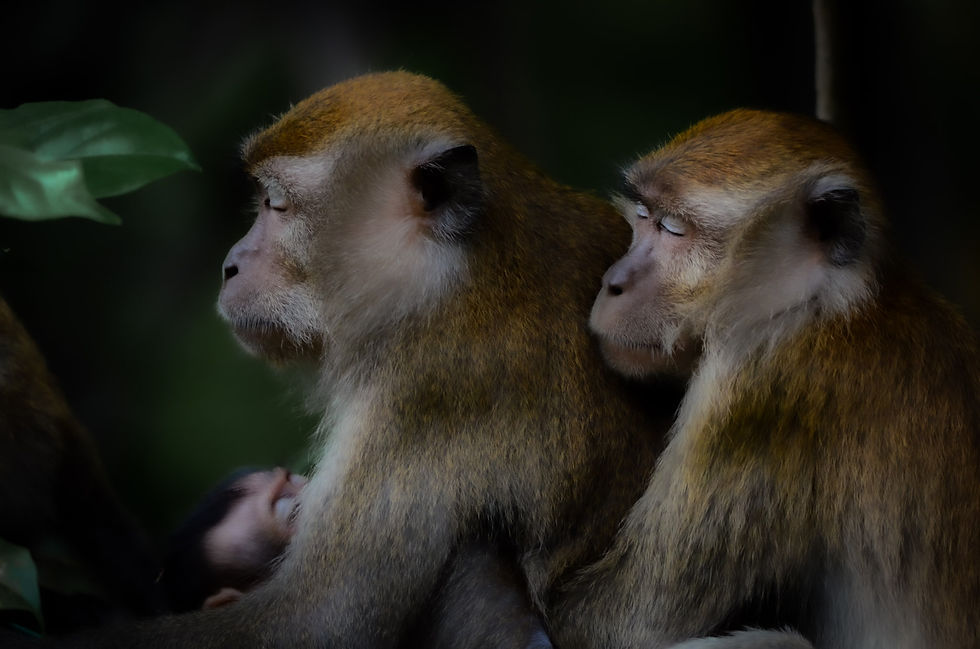All The Things Macaques Are
- Jane Goodall Institute Singapore

- Dec 14, 2023
- 4 min read
Updated: Jan 8
Article by Amos Chua, JGIS Programme Manager
December 2023
We, humans, are primates and we are one of the four primate species living in Singapore. The other three primates are the long-tailed macaque (Macaca fascicularis), the Raffles’ banded langur (Presbytis femoralis) and the Sunda slow loris (Nycticebus coucang). We celebrate this year’s World Monkey Day (14 December 2023) by spotlighting our curious and intelligent little friends – the long-tailed macaques!
While these monkeys may appear smaller, furrier, and have a long tail, they are a lot more similar to us than we think. How so? Here are all the things macaques are!

(Subadult macaque giving juvenile macaque a piggyback. Photo credit: Amos Chua)
They are adaptable and skillful.
Like us, long-tailed macaques make use of their intelligence to learn and adapt to their environment.
In Singapore, they can thrive in a wide range of habitats – primary forest, secondary forest, coastal forest, mangroves, swamp forest, forest edges, and urban environments. They have a general diet and enjoy eating crabs, snails, insects, fruits, and plant parts such as flowers and leaves.
With their dexterous hands, they fish for the invasive apple snails (Pomacea canaliculata)
in shallow waters.

(An adult macaque catching a golden apple snail. Photo credit: Amos Chua)
With their strong canines, they can bite into tough fruits such as the cempedak (Artocarpus integer)!

(An adult macaque feeding on cempedak. Photo credit: Amos Chua)
Hence, they are important for maintaining Singapore’s ecosystem by controlling invasive species population and dispersing seeds across the forests to sustain flora regeneration.
When they need to travel, they keep extra food in their cheek pouches to ensure that they have enough for the journey.

(A subadult macaque storing African oil palm (Elaeis guineensis) seeds in its cheek pouch. Photo credit: Amos Chua)
Their natural predators include raptors such as the changeable hawk-eagle (Nisaetus cirrhatus) and large snakes such as the reticulated python (Malayopython reticulatus). To avoid these predators, they adopt several strategies – they produce their ‘kra’ alarm calls (Fun fact: they are also known as ‘kra monkeys’) to alert all the other macaques in the area, they hide down under the shrubs or up in the treetops to avoid raptors or large snakes, and sometimes they ‘gang up’ together, using their large numbers to deter predators.
They are social animals with different personalities.
Like us, long-tailed macaques value their friends and families, and display a range of emotions and personalities.
After spending time feeding, travelling, and avoiding predators, their favourite pastime activity is socialising through grooming and playing. These activities are important for strengthening social bonds among each other, providing stress-relieving comfort, and learning new skills.

(An adult macaque groomed by a subadult and juvenile macaque. Photo credit: Amos Chua)

(Two juvenile macaques play-fighting with each other. Photo credit: Amos Chua)
Staying in a troop (monkey group) enables them to learn vital survival and social skills such as foraging and grooming, respectively.

(A juvenile macaque observing its mother cracking a fruit shell. Photo credit: Amos Chua)

(An infant macaque grooming a juvenile macaque. Photo credit: Amos Chua)
They have feelings and display a range of emotions and personalities through their facial expressions.
They show contentment and affiliation, through lip-smacking, when grooming or playing with their friends and families.

(An adult macaque lip-smacking at another adult macaque. Photo credit: Amos Chua)
They show fear and submissiveness, through bare-teeth grinning, when encountering threats such as predators or dominant macaques. (Note: This is NOT a smile; It is NOT a happy face)

(A juvenile macaque grinning at an adult macaque. Photo credit: Amos Chua)
They show anger and agitation, through open-mouth stares, when they feel threatened or defending their loved ones.

(An adult macaque in a mock charge stance with an open mouth stare. Photo credit: Amos Chua)
They are a part of Singapore.
And finally, like us, they call Singapore their home.
Long-tailed macaques have been living in Singapore for a long time (the earliest fossil record indicates that they inhabited the region approximately 1 million years ago). Today, habitat loss, road kills, wildlife trade and negative human-wildlife interactions are major threats to long-tailed macaque populations in the region. We need to protect our wild neighbours because they are an important part of Singapore’s natural heritage, and help to ensure that our ecosystem is healthy.
There is so much we can learn about ourselves from them. Here are some tips you can follow to better appreciate and coexist with our primate neighbours:
Do not feed the macaques. As shown above, they have plenty of food in their natural environment and they are capable of finding their own natural food source. Feeding perpetuates negative human-wildlife interactions.
Remove any source of attractants (e.g. keep all plastic bags out of sight, and ensure that bins and home windows are closed and secured). This discourages macaques from visiting potential food sources.
Always observe the macaques from a distance. If a macaque approaches you, stay calm and walk away from it. If a macaque is in your path, find an alternative route.
Do not stare or bare your teeth at them. The macaques can misunderstand your intentions and feel threatened and will defend themselves if they have to.
Understanding these animals through education and awareness is the first step to coexistence. Let us live happily and peacefully with all of our wild neighbours and strive towards a wonderful City in Nature!

(Two adult macaques and an infant macaque resting. Photo credit: Amos Chua)
Follow Jane Goodall Institute (Singapore) to learn more about macaques:
 | Website: www.janegoodall.org.sg Facebook: www.facebook.com/JaneGoodallSingapore Instagram: @JaneGoodallSG Twitter: @JaneGoodallSG YouTube: @janegoodallinstitutesingap5998 LinkedIn: www.linkedin.com/company/jane-goodall-institute-singapore |
Visit OWN macaques information page and download our advisory to get practical tips on what you can do when you encounter one:




Comments